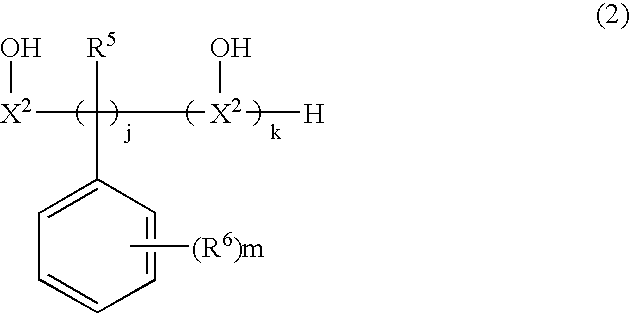Resin composition for insulating layer for multi-layered printed board
a technology of insulating layer and resin composition, which is applied in the direction of printed circuit aspects, dielectric characteristics, coatings, etc., can solve the problems of no insulating material which is able to form a rough surface having such a property, low roughness and high peel strength, and achieves good tight adhesion, easy introduction, and high adhesive force
- Summary
- Abstract
- Description
- Claims
- Application Information
AI Technical Summary
Benefits of technology
Problems solved by technology
Method used
Image
Examples
example 1
[0105] Liquid epoxy resin of a bisphenol A type (epoxy equivalent weight: 180; “Epikote 828 EL” manufactured by Japan Epoxy Resins Co., Ltd.) (28 parts) and 28 parts of tetra-functional epoxy resin of a naphthalene type (epoxy equivalent weight: 163; “EXA-4700” manufactured by Dainippon Ik and Chemicals, Inc.) were dissolved in 15 parts of methyl ethyl ketone (hereinafter, abbreviated as MEK) and 15 parts of cyclohexanone by heating with stirring. Then 110 parts of an MEK solution of novolak resin of a naphthalene structure which was a phenolic curing agent (“SN-485” manufactured by Tohto Kasei Co., Ltd.; phenolic hydroxy group equivalent: 215; average hydroxyl group amount in a molecule: 1 / 3˜2 / 5) in solid amount of 50%, 0.1 part of a curing catalyst (“2E4MZ” manufactured by Shikoku Chemicals Co.), 77 parts of spherical silica (average particle size: 0.5 μm; “SOC2” manufactured by Admatechs Co., Ltd.), 9 parts of core-shell rubber particles (average particle size: 0.5 μ; “AC-3816N” ...
example 2
[0106] Liquid epoxy resin of a bisphenol A type (epoxy equivalent weight: 180; “Epikote 828 EL” manufactured by Japan Epoxy Resins Co., Ltd.) (28 parts) and 28 parts of tetra-functional epoxy resin of a naphthalene type (epoxy equivalent weight: 163; “EXA-4700” manufactured by Dainippon Ink and Chemicals, Inc.) were dissolved in 15 parts of MEK and 15 parts of cyclohexanone by heating with stirring. Then 75 parts of an MEK solution of novolak resin which was a phenolic curing agent containing thiomethyl group (“YLH-1110L” manufactured by Japan Epoxy Resins Co., Ltd.; phenolic hydroxy group equivalent: 168; average hydroxyl group amount in a molecule: 1 / 3˜1 / 2) in solid amount of 60%, 0.1 part of a curing catalyst (“2E4MZ” manufactured by Shikoku Chemicals Co.), 72 parts of spherical silica (average particle size: 0.5 pm; “SOC2” manufactured by Admatechs Co., Ltd.), 9 parts of core-shell rubber particles (average particle size: 0.5 μ; “AC-3816N” manufactured by Ganz Chemical Co., Ltd....
example 3
[0107] Liquid epoxy resin of a bisphenol A type (epoxy equivalent weight: 180; “Epikote 828 EL” manufactured by Japan Epoxy Resins Co., Ltd.) (28 parts) and 28 parts of tetra-functional epoxy resin of a naphthalene type (epoxy equivalent weight: 163; “EXA-4700” manufactured by Dainippon Ink and Chemicals, Inc.) were dissolved in 15 parts of MEK and 15 parts of cyclohexanone by heating with stirring. Then 65 parts of an MEK solution of novolak resin which was a phenolic curing agent (“YLH-1027” manufactured by Japan Epoxy Resins Co., Ltd.; phenolic hydroxy group equivalent: 120; average hydroxyl group amount in a molecule: 1 / 3˜1 / 2) in solid amount of 60%, 0.1 part of a curing catalyst (“2E4MZ” manufactured by Shikoku Chemicals Co.), 67 parts of spherical silica (average particle size: 0.5 μm; “SOC2” manufactured by Admatechs Co., Ltd.), 8 parts of acrylate rubber particles (average particle size: 0.2 μ; “W-450A” manufactured by Mitsubishi Rayon Co., Ltd.) and 27 parts of phenoxy resi...
PUM
| Property | Measurement | Unit |
|---|---|---|
| temperature | aaaaa | aaaaa |
| softening points | aaaaa | aaaaa |
| softening points | aaaaa | aaaaa |
Abstract
Description
Claims
Application Information
 Login to View More
Login to View More - R&D
- Intellectual Property
- Life Sciences
- Materials
- Tech Scout
- Unparalleled Data Quality
- Higher Quality Content
- 60% Fewer Hallucinations
Browse by: Latest US Patents, China's latest patents, Technical Efficacy Thesaurus, Application Domain, Technology Topic, Popular Technical Reports.
© 2025 PatSnap. All rights reserved.Legal|Privacy policy|Modern Slavery Act Transparency Statement|Sitemap|About US| Contact US: help@patsnap.com



